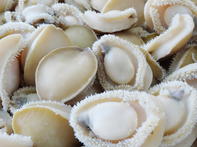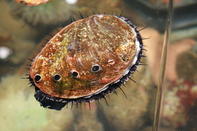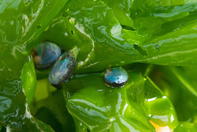The farming of abalone in South Africa is in land-based systems along the coast, mainly in the Southern Cape, but there are also abalone farms in the Northern Cape and in the Eastern Cape Provinces.

An application for a land-based abalone holding and processing facility near Kleinzee is being considered and in 2018, a permit was allocated for the harvesting and export of seven tonnes of seeded abalone from the ocean in the Eastern Cape. In this Eastern Cape ocean-based abalone farming system, hatchery-reared abalone was seeded in the ocean and allowed to grow in a ranching system.
Abalone production is closed life-cycle aquaculture covering the life cycle from spawning, growing, harvesting and selling of abalone and runs for around 45 months. All processing is done on the site of the abalone farms.
In South Africa, abalone farming is based on the species Haliotis midae, also known as the South African abalone or ‘perlemoen’. This large sea snail can grow up to 20 cm and is endemic to South Africa.
Most of the South African abalone product goes into the market as canned or live (40% each), with a smaller portion as dried (15%) and 5% as a frozen or minced product.
Advantages of Abalone Farming in South Africa

South Africa, produces top quality abalone in sophisticated systems and is the largest producer of abalone apart from the Asian abalone producers. There are, however, challenges and opportunities to further grow the export of South African abalone.
South Africa has a good local abalone species - Haliotis midae - with good market demand.
South Africa’s locally produced abalone feed is probably the best in the world.
Even though the South African abalone industry is still young - only about 25 - 30 years in existence - South Africa has already developed the technology and know-how to farm this species to a very high standard, says Matt Naylor, production manager of HIK Abalone Farm in Hermanus.
With more innovation and research, South African abalone farms should be able to produce larger and more abalone and reduce the production cost.
Feeding Abalone

Some abalone farms feed a locally produced artificial abalone feed, while some feed a combination of artificial diet and wild harvested kelp or the green seaweed Ulva, which they grow themselves.
According to research, abalone shows better growth rates, meat yields and feed conversion ratio (FCR), when fed specially formulated abalone feed, compared to feeding only kelp (mainly Ecklonia maxima) or a combination of kelp and artificial feed.
During the grow-out phase, abalone is fed an artificial diet with a crude protein content varying between 26 - 34%. Protein content varies depending on the growth stage and water temperature. The abalone feed is in the form of pellets, ranging from 1mm grains for weaning spat to flat strips for larger abalone.
Despite a lack of consistency in research results, there is enough evidence to suggest that a combination of seaweed is optimal for different species abalone at different life stages. These mixed diets can better increase growth rates and overall lifespan as compared to only feeding artificial feeds.
Research by the South Australian Research and Development Institute (SARDI) has shown that there is a direct link between water temperature, the protein content of abalone feed and the growth rate of the animals. Very little growth occurred at 14℃ in any growth stage, while a protein level of 31 - 37% encouraged the growth of juvenile abalone in warmer water temperatures.
As the above illustrates, there is a multitude of aspects influencing the optimum growth of abalone, emphasising the technologically intricate business of farming abalone.
Water Conditions for Growing Abalone
Water temperature impacts abalone larval development and should ideally be around 18℃.
Depending on where the abalone farm is located along the South African coast, the grow-out phase is between 1,5 and 1,7 mm per month. This can take 36 - 45 months.
The optimal water conditions for abalone farming is a pH of 6.5 – 8.5 and salinity of 30 - 35 ppt.
Testing Abalone
South African abalone farms and factories are HACCP and ISO approved and comply with international quality and hygiene standards.
Live abalone, water quality and each shipment are regularly tested for microbiological contamination (e.g. Salmonella and E. coli), heavy metals (e.g. lead and mercury), pesticides, radiation and biotoxins.
By Marinda Louw